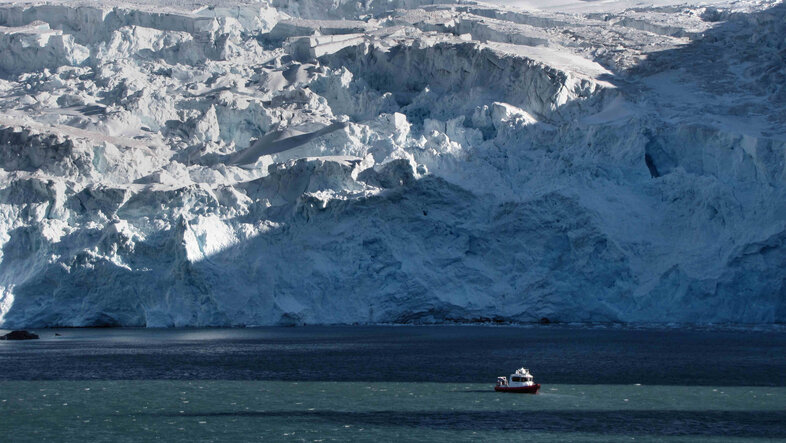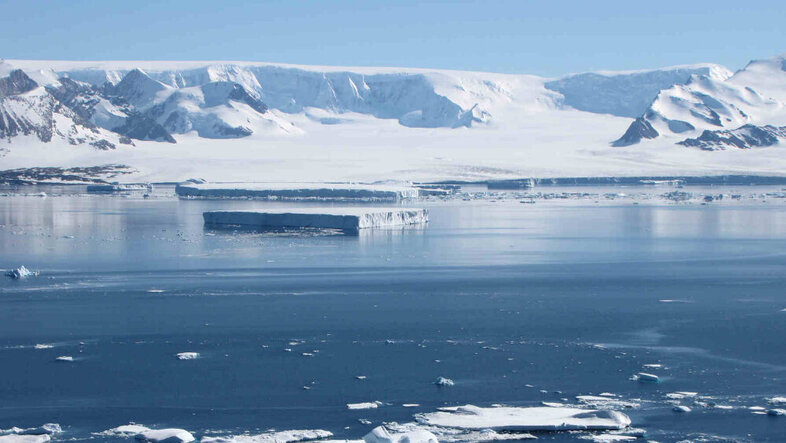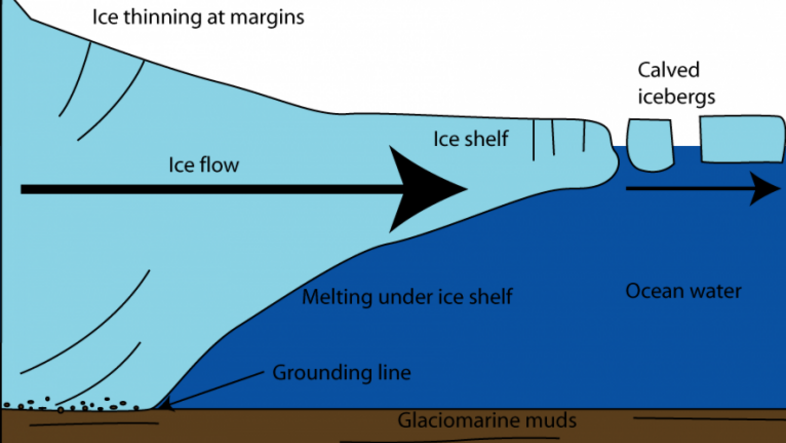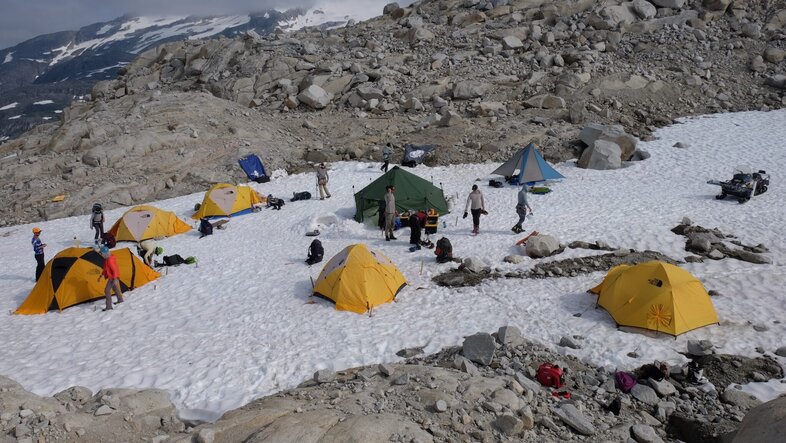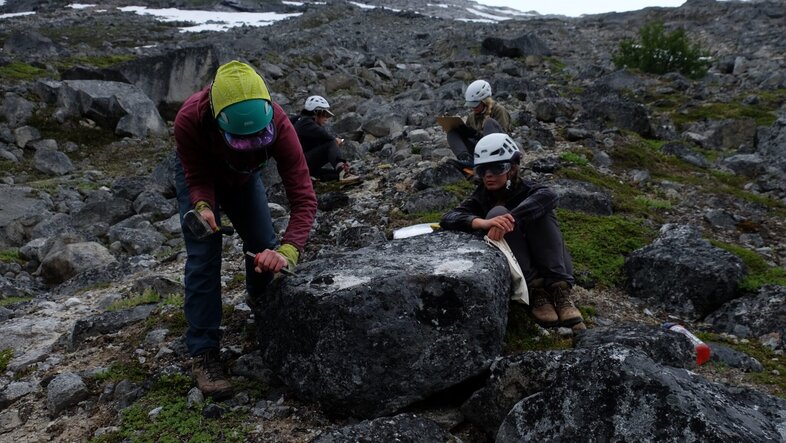Melting glaciers and their future
Rudolphina: You are analysing the interaction between glaciers and climate. Why did you decide to focus on this topic in the first run?
Bethan Davies: Well, climate change is one of the major challenges humanity is facing. It’s going to affect everyone in the world - and it’s going to affect some of the most disadvantaged people the most. Glaciers and ice-sheets are a really iconic and symbolic representation of climate change. As temperature is rising, worldwide glaciers are shrinking. This reduces the amount of water available for people – for farming, for industry, for irrigation, also for power generation, like here in Austria, and this also effects many other economic sectors, like tourism. In countries that have a coastline, the melt of glaciers of the Antarctic ice-sheet is also going to affect the coastal cities and their infrastructure – in the United Kingdom, where I come from, a lot of infrastructure is going be threatened in the next 100 years due to the sea level rise. Therefore, it is absolutely vital to know how much glaciers and ice-sheets are going to shrink in the future and how they are behaving today. The only way in which we can have any degree of confidence in their future behaviour is by using computer models that are evaluated against the past.
"We need to have strong careful reconstructions of past glaciers behaviour"Bethan Davies
Rudolphina: So while you are analysing the present and trying to look into future, you are actually relying on the geological past?
Davies: Absolutely, yes. We need to have strong, careful reconstructions of past behaviour in the different climatic situations that we can then use to evaluate simulations for the future. For this we can use the satellite imagery of the last 40 years or so, photographs that people have taken from aeroplanes or earlier from balloons, and maps – they may date back some centuries, in the case of the Austrian glaciers back to 1800. But we really can’t go back beyond that. So, we have to use the geological record in order to reconstruct how glaciers behaved in the pre-industrial era and over long time-scale, especially also in periods of past record climate change like 11.000 years ago, when the Holocene started. In order to understand this we use the records in the sediments: The geomorphological footprint, so to say, the glacier has left behind.
Rudolphina: In your research you are concentrating on the ice-bed-interface. Why is it so important to understand what is happening underneath the glacier?
Davies: How a glacier is behaving depends on the interface between the ice and what the ice is resting on and especially on the presence or absence of water at this ice-bed-interface. By looking on sediments or by crawling underneath the ice, which I do sometimes, we can understand the nature of this ice-bed-interface.
Rudolphina: How much does the presence of water affect the melting of glaciers?
Davies: If the glacier is frozen to the bed, it flows very, very slowly, and only by deformation of the ice. If there is water underneath, the glacier slides and flows a lot faster. We have all been on wet ice falling over, so we all know that wet ice is slippery. For example, Pine-island glacier in Antarctica - one of Antarctica’s and the world’s largest ice streams - is flowing very fast. That means that a lot of mass is transported from the centre of the ice-sheet to the margins. So understanding the nature of the bed is vital to correctly parameterise the computer models and to understand how these glaciers are going to behave in the future.
Rudolphina: Which regions do you concentrate on in your research?
Davies: I’m interested in the past records and behaviour of glaciers worldwide. This year I’ve been doing fieldwork in Svalbard, in Alaska and also in Chile at the Patagonian ice-sheet. Patagonia is constrained and controlled by Antarctic signals; we see different patterns in Northern Atlantic regions, we see different patterns in Alaska, and then we also see something else in the high Arctic, in Svalbard. By using these past records of glaciers, we can understand global patterns of climate change and we can link together global teleconnections between different hemispheres, between the East and the West and the North and the South.
Rudolphina: You are especially interested in the glacier change in Patagonia – why?
Davies: The Patagonian ice sheet is of particular interest for me, because it is very long and very thin and strongly controlled by the Southern Westerly winds. While these winds contract further South and expand further North, the glacier advances and shrinks. Southern westerly winds are also currently driving the major changes that we are seeing in Antarctica, especially oceanic circulation changes, which are causing ice to melt in Antarctica underwater. So the Patagonian ice sheet can serve as a proxy for these changes – we can use it to understand what is happening in Antarctica today and how it might behave and change in the future: What is normal, what is not normal – what is human driven and what is not.
"In Western Antarctica we see a really rapid recession of major ice streams"Bethan Davies
Rudolphina: And what is happening in Antarctica today?
Davies: All along the coast of Western Antarctica, we see a really rapid recession of the major ice streams. We have ice shelves, which are the floating extension of land ice. Due to the changes because of climate change, warm currents are getting underneath these ice shelves and thinning the floating ice. Ice shelves are very important, because they act like an elastic band and keep the ice on the land. If we take away these elastic bands, the glaciers on land flow into the sea and drive sea level rise. Western Antarctica has a sea level potential of 3.3 meters, and it has the potential to drain into the ocean very, very fast, because it’s on an unstable bed. This of course would have major implications for sea level rise in the future.
Rudolphina: Following your analysis, which sea level rise are we talking about until the year 2100?
Davies: We are looking at about 25 cm sea level rise from global ice (Antarctica, Greenland and glaciers) by around 2100 at the moment, relative to today, under current policies. That could be higher, or lower, depending on the carbon pathway we are going to take. Together with thermal expansion of the ocean, the IPCC reports that total sea level rise would be 0.44 to 0.76 m by the year 2100 under this intermediate greenhouse gas emissions scenario. Sea level rises of this magnitude mean that extreme sea level events that occurred once per century in the recent past would occur at least annually by the year 2100 AD at many places worldwide. Sea level rise would contribute to increased coastal flooding and coastal erosion. If we can decrease our emissions to limit warming to less than 1.5°C, then land-ice contributions to sea level rise would decrease to 13 cm. This would give a total mean sea level rise of 0.28 to 0.55 m (relative to the year 2014) under this very low greenhouse gas emissions scenario. But over the next 2000 years, we’d still see a total sea level rise of 2-3 m under this warming scenario, and it would be much higher under an intermediate or higher emissions scenario.
Rudolphina: Which methods to you use to explore the interaction between ice and bed at different time scales?
Davies: I use lots and lots of different methods, first of all remote sensing – here we use technology that allows us to see things without touching them: This includes satellite imagery, photographs, drawn imagery, even photographs from my mobile phone camera. I use these technologies to reconstruct the past footprint of the glacier. I’ll use the sediments to understand processes, to understand how the glacier was behaving, whether it was melted or frozen to the bed, or maybe half and half and try and think about was driving these glacial changes. I can use field surveys – so that’s when I physical walk around and observe features. And I can use features like microscopic analysis of the sediments themselves: I can impregnate the sediments with resin, slice them to the thickness of a human hair, mount them on a microscope slide and then look in really amazing detail on what was happening underneath the bed of the glacier.
Rudolphina: What are the things you can see in these amazing details, though?
Davies: I can tell you whether the sediment was rotating, whether the grains were rotating and rolling within the sediment or if the sediment was under very high strain. A lot of the geological structures we might see at much bigger scale, we can see in these microscopic slides. From this we can make inferences about the conditions of the glacier.
Rudolphina: You are also teaching a course on glaciers and climate change. Which central message should your students remember?
Davies: The course is about how glaciers interact with the climate, so it’s about how glaciers work fundamentally, which we call process glaciology, and then how we can work with that knowledge to predict the behave of the glacier in the future. So once students finished the course, they should have good understanding of how glaciers interact with climate, how we can use models to understand their current and future behaviour, and why they might want to look to the past in order to better predict the future.
Rudolphina: Why did you decide to do research and teach at the Faculty of Earth Sciences, Geography and Astronomy of the University of Vienna?
Davies: I have been working for a long time with some of the people within the Faculty of Earth Sciences, Geography and Astronomy, especially with Daniel Le Heron. So the Ida Pfeiffer Professorship struck me as a good opportunity to come and deepen our collaboration, to learn from each other and to develop new and interesting collaborations for sharing knowledge and best practice.
During the winter term 22/23, Bethan Davies is Ida Pfeiffer Professor at the Faculty of Earth Sciences, Geography and Astronomy of the University of Vienna.
- Glaciers and Glaciation in Antarctica and beyond
- Climate Change and Antarctica
- Faculty of Earth Sciences, Geography and Astronomy
- Ida Pfeiffer Professorship
- The evolution of the Patagonian Ice Sheet from 35 ka to the present day (PATICE)
- Topographic controls on ice flow and recession for Juneau Icefield (Alaska/British Columbia)
- Dynamic ice stream retreat in the central sector of the last British-Irish Ice Sheet
